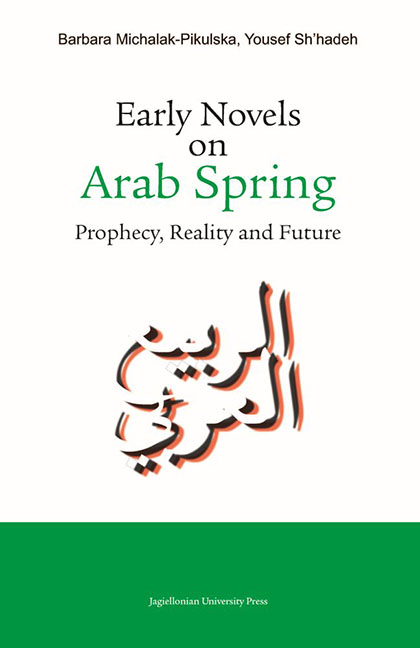Book contents
- Frontmatter
- Contents
- Introduction
- Part I Awakening of the Awareness of Subjugation – The Prophecy of the Spring of Nations in Arab Novels
- Part II At the Heart of the Arab Spring Events
- Part III The Future: The Spring Continues
- 17 Mu‘Taṣim Aš - Šā‘Ir : Uhzūǧat ar-raḥīl (A Song of Departure) and Fī intiẓār as-sulaḥfāt (Waiting for a Turtle)
- 18 Aḥmad ‘Abd Al - Malik : Al-Aqni‘a (Masks)
- 19 Ṭayba Aš - Šarīf Al - Idrīsī : Ḥaǧar min saqar (A Stone from Hell)
- 20 Amīra Aš - Širbīnī : ‘Itq (Liberation)
- 21 ‘ Izz Ad - Dīn Šukrī Fašīr : Bāb al-ẖurūǧ – risālat ‘Alī al-muf‘ama bi-bahǧa ġayr mutawaqqa‘a (The Gate to Leave – Ali’s Letter Filled with Unexpected Joy)
- Conclusion
- Bibliography
- Summary in Arabic
15 - Ibrāhīm Al - Kūnī : Fursān al-aḥlām al-qatīla (The Knights of Slain Dreams)
Published online by Cambridge University Press: 13 October 2023
- Frontmatter
- Contents
- Introduction
- Part I Awakening of the Awareness of Subjugation – The Prophecy of the Spring of Nations in Arab Novels
- Part II At the Heart of the Arab Spring Events
- Part III The Future: The Spring Continues
- 17 Mu‘Taṣim Aš - Šā‘Ir : Uhzūǧat ar-raḥīl (A Song of Departure) and Fī intiẓār as-sulaḥfāt (Waiting for a Turtle)
- 18 Aḥmad ‘Abd Al - Malik : Al-Aqni‘a (Masks)
- 19 Ṭayba Aš - Šarīf Al - Idrīsī : Ḥaǧar min saqar (A Stone from Hell)
- 20 Amīra Aš - Širbīnī : ‘Itq (Liberation)
- 21 ‘ Izz Ad - Dīn Šukrī Fašīr : Bāb al-ẖurūǧ – risālat ‘Alī al-muf‘ama bi-bahǧa ġayr mutawaqqa‘a (The Gate to Leave – Ali’s Letter Filled with Unexpected Joy)
- Conclusion
- Bibliography
- Summary in Arabic
Summary
When the revolution broke out in Libya, Ibrāhīm al-Kūnī described man’s behavior in life-threatening conditions and his way of thinking. The author shows the uprising principally as an uprising of young, inexperienced people who sacrificed their lives to fight for a better future. Still, they fear that history may repeat itself and the new power may not be better than the previous one. This is a warning against totalitarianism and the imperfection of human nature, for it is man who is responsible for the path he chooses. Through the example of protagonists devoted to the dictatorship, the author shows the process of becoming addicted to false ideology. All the infractions perpetrated by those who swore their allegiance to the regime: hatred, rape, pain, the exploitation of human weakness, and even murder have been strongly condemned in the work under discussion.
The main theme of the novel Fursān al-aḥlām al-qatīla (The Knights of Slain Dreams) is the Libyan revolution that broke out on February 17, 2011. The main character and narrator is Ġāfir. He belongs to the representatives of the Libyan intelligentsia. He was once a teacher but was fired because of his opposition to falsifying history and worshiping Gaddafi. The novel takes place in a building in Misrata (Mişrāta), where the fate of Gaddafi and all of Libya was decided. The work describes the course of the revolution on the streets of that city.
Ġāfir tells how, along with his companions, he wanted to knock out a passage in the wall to get to the tallest skyscraper in Misrata called Aḍ-Ḍamān and to eliminate Gaddafi’s snipers who were there, who shot everyone who went out into the streets of the city. However, Ġāfir got stuck in a building that was attacked by Gaddafi’s forces. He hid under sandbags in one of the rooms on the third floor, where he heard the conversations of soldiers below. Sidra was on the second floor with her two children. The hero heard the conversations of the enemies and their beastly treatment of the woman.
- Type
- Chapter
- Information
- Early Novels on Arab SpringProphecy, Reality and Future, pp. 105 - 110Publisher: Jagiellonian University PressPrint publication year: 2022



